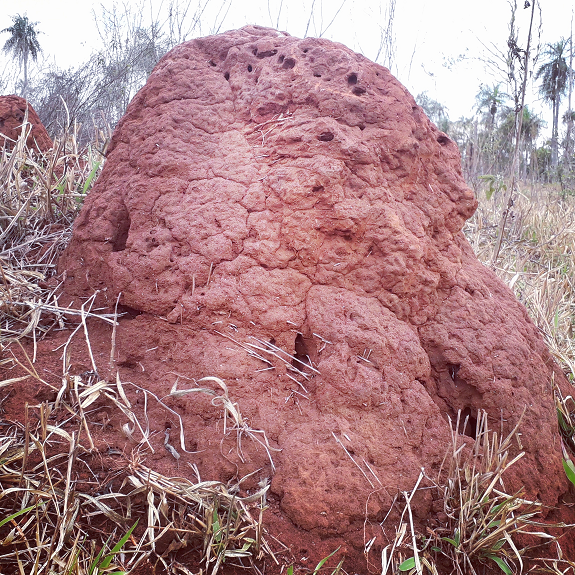Termite mounds are a common sight throughout Paraguay. Their solid orange bulk rising from the ground. Almost no views of the countryside lack at least one. In terms of numbers they are possibly the most common creature in the land.
Termites are found not just in Paraguay but all across the world. Where ever the climate is suitable they colonize the land. There are species to be found in every continent except Antarctica. Each with its own habits and preferred environment.
Many build large subterranean nests the mounds of which rise high into the air. Others build their nests in the air. Placing them high up in trees.
In all there are known to be at least 3000 individual species of termites across the world.
Termites are insects of the order Isoptera. Although in appearance they may resemble ants they are not related to them. The closest relatives to the termite are in fact the cockroaches.
Like ants, wasps and bees termites live in large colonies. There the members of the community are divided into clearly defined castes.
In the case of termites the colony is centered around a king and queen. Beyond them the activities of the colony are shared between workers and soldiers.
The king and queen can live for tens of years and over that time produce hundreds of thousands of offspring. If the queen were to die then a secondary queen would take her place to continue the expansion of the community.
The workers perform all the chores required to keep the colony functioning. The soldiers repel invaders and defend any breaches in the mound until workers are able to seal it.
The main predators of termites are ants. Though breaks in a mound they will seek to gain entry. There soldiers will defend the colony with both their pincers and bodies as workers rush to block up the gap.
If ants do break into a mound they will seek to destroy and eliminate any termites they find within. If ever I break open a dead and abandoned mound I will find ants swarming within.
In the darkness of the mound sight is of no assistance. Accordingly almost all termites are blind relying on chemical signals for their instructions.
The most common type of termite found across Paraguay builds large dome shaped mounds. Due to the colour of the soil these are invariably bright orange. A termite mound is easily spotted amongst the green grasses.
These mounds are hard as rocks. The heavy rains of Paraguay would soon wash away a mound of soil. So the termites add their secretions to the soil as the mound is built to hold everything together. This not only makes the mound almost indestructible it also makes it water proof.
This visible mound is only the tip of the nest. Below ground there is a round construction far larger than the visible mound. Deep within this live the king and queen.
The main food source for termites is dead plant material and cellulose. Termites recycle vast amounts of plant materials. They are a vital part of the natural ecosystem.
However this also can make them a pest to humans and a danger to their buildings. Just a few years ago in Paraguay renovations required by the Presidential Palace turned out to be far more extensive and expensive than initially planned for when a termite infestation was discovered.
I have to live with termites and know that they cannot and should not ever be entirely eradicated. Instead I seek to control them.
Over the years all the mounds near the house have been dug up. Now although there will always been mounds in the garden they have been driven a distance from the house and anything they may damage.
The large mounds that the termites build remain solid structures long after either due to the death of the king and queen or because of ants the termites have gone.
Once abandoned other animals can move in. A snake may find its way in though an air shaft and set up home in the old nest chamber. Or if the side of the mound has broken open a family of owls or armadillos may move in.
Whether seen as a blessing or a curse depends very much upon where they appear. Either way termites are a vital part of the environment and ecosystem of Paraguay.


Nice post. 3k species of termite and 3k species of cicadas. What are the odds?
I’m wondering about this kind of aggressive bird that you see in fields. Sometimes they come flying straight towards you only to veer at the last moment. I’ve heard they nest on the ground but can never find their eggs.
Now what are the odds of that?
As for the birds. Black and white wings and very vocal? Southern Lapwings. They are ground nesting and if you ever get close to finding a nest they will let you know
Yes, those are the ones. I forget the name used in Paraguay. I’m out in the fields with my dogs but even they have never found a nest.